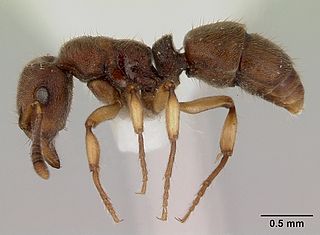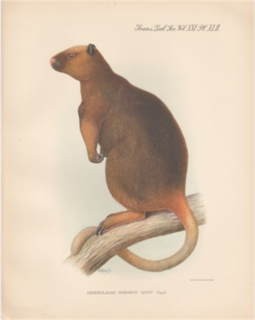In mathematics, the theta divisor Θ is the divisor in the sense of algebraic geometry defined on an abelian variety A over the complex numbers by the zero locus of the associated Riemann theta-function. It is therefore an algebraic subvariety of A of dimension dim A − 1.

Heteroponera brouni is a species of ant in the genus Heteroponera. It is endemic to the North Island of New Zealand, and the Three Kings Islands.

Anochetus is a genus of carnivorous ants found in the tropics and subtropics throughout the world.

Procryptocerus is a Neotropical genus of gliding ants, with the ability to "parachute" by steering their fall if they drop off of the tree they're on.

Aphaenogaster mayri is an extinct species of ant in formicid subfamily Myrmicinae known from a series of Late Eocene fossils found in North America. A. mayri was one of two Aphaenogaster species described in a 1930 paper by Frank M. Carpenter.
Heteroponera crozieri is a species of ant in the genus Heteroponera endemic to Australia. Described in 2011, the workers look similar to those of Heteroponera leae, although H. leae ants are more southerly distributed.
Heteroponera dolo is a species of ant in the genus Heteroponera, endemic to Argentina, Brazil, Paraguay and Uruguay. It was described by Roger in 1860.

Heteroponera flava is a species of ant in the genus Heteroponera. Endemic to Brazil and Paraguay, it was described by Kempf in 1962.

Heteroponera inca is a species of ant in the genus Heteroponera. Endemic to Colombia, it was described by William Louis Brown Jr. in 1958.
Heteroponera inermis is a species of ant in the genus Heteroponera. Endemic to Brazil, it was described by Emery in 1894.
Heteroponera leae is a species of ant in the genus Heteroponera. It is endemic to Australia, and was described by Wheeler in 1923. It has a similar appearance to Heteroponera crozieri ants, although H. crozieri ants are more northerly distributed.
Heteroponera majeri is a species of ant in the genus Heteroponera. Endemic to Australia, it was recently described by Taylor in 2011. Its appearance is far different to other Heteroponera species that reside in Australia.

Heteroponera microps is a species of ant in the genus Heteroponera. Endemic to South America, it was described by Borgmeier in 1957.
Heteroponera monticola is a species of ant in the genus Heteroponera. Described by Kempf and Brown in 1970, Colonies are mainly inhabit high wet regions in Colombia, particularly in parts where ants of whatever kind are scarce.

Heteroponera panamensis is a species of ant in the genus Heteroponera. Endemic to Costa Rica and Panama, It was described by Forel in 1899.
Heteroponera relicta is a species of ant in the genus Heteroponera. Endemic to Australia, it was described by Wheeler in 1915.
Heteroponera robusta is a species of ant in the genus Heteroponera. Endemic to Brazil, it was described by Kempf in 1962.
Dolichoderus andinus is a species of ant in the genus Dolichoderus. Described by Kempf in 1962, the species is only endemic to Peru.

The Wondiwoi tree-kangaroo is a mammal species in the genus Dendrolagus. It was known until recently from a single specimen which was collected in 1928. The only known specimen is a male weighing 9.25 kilograms (20.4 lb). D. mayri was located in the Wondiwoi Peninsula of West Papua at an elevation of 1,600 metres (5,200 ft) within montane forest. It is thought that the Wondiwoi tree-kangaroo could occupy an area of 300 square kilometres (120 sq mi). Global Wildlife Conservation, the wildlife conservation charity, lists the Wondiwoi Tree Kangaroo as one of their "25 Most Wanted Lost Species".











